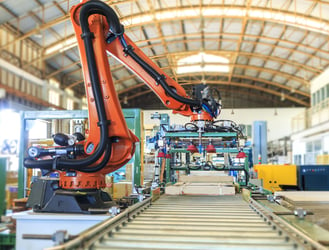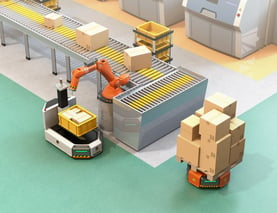Automated warehouse systems are a great way to streamline the functions of a warehouse to improve efficiency, flexibility, reliability and turnaround time. These systems dramatically improve a range of aspects of warehousing and the distribution of goods, as, in an automated warehouse, processes such as retrieval, storage, and movement of goods are carried out automatically. This means that the staff in the warehouse do not need to undertake monotonous and strenuous tasks, and error-rates are low.
Warehouse Operations That Can Be Automated
Warehouses are rife with repetitive, laborious, process-oriented and error-prone tasks. An automated warehouse system identifies these tasks and develops a way to automate them. Some of the warehouse operations that will benefit from automation are:
- Picking – traditional picking in a warehouse depends on manual labour and is repetitive and time-consuming. However, warehouse robotics and shelving systems automate the picking process to improve efficiency and eliminate human error.
- Scanning – document keeping in a warehouse is critical for tracking incoming and outgoing items. By automating the documentation processes with rack labels, warehouse signs, and barcode labels, as well as the machinery to read these labels, a warehouse saves a lot of time. Scanning automation improves the speed and efficiency of the documentation process.
- Vehicle processing – traditional warehouses use pallet jacks and forklifts to move goods. But thanks to advances in technology, automated guided vehicles or AGVs, have revolutionised the movement of goods in a warehouse. AGVs do not need human operators, and instead follow digital paths to load and unload containers.
- Inventory management – pen and paper methods are prone to errors and can cause inconsistent inventory processing and disruption to the warehouse operations. The inventory management process is one of the most cost-effective and easiest strategies to automate in a warehouse.
- Back-office tasks – inventory automation can be easily extended to cover back-office processes. Automated back-office processes provide access to real-time data, leading to precise and exact inventory counts.
Automated Warehouse Systems VS Manual Warehouse Processes
 Companies stand to benefit most from keeping up to date with the latest technologies, rather than sticking with outdated, manual processes. The following are several advantages of using automated systems in a warehouse:
Companies stand to benefit most from keeping up to date with the latest technologies, rather than sticking with outdated, manual processes. The following are several advantages of using automated systems in a warehouse:
- Lack of human error – automated warehouse systems end human error leading to well-organised warehouse processes. Any error that occurs in an automated warehouse is easy to track and correct.
- Throughput optimisations – manual warehouse processes are slow and time-consuming, leading, in turn, to slow product delivery. Automated warehouse systems streamline operations for faster delivery of goods to the customer. One-off purchasers become loyal customers when delivery speed beats their expectations.
- Lower risk injury – a warehouse that relies on human labour experiences a higher level of injury risk, as employees are exposed to hazards while on the job. On the other hand, automated warehouse systems need little or no human input to run, eliminating this risk.
- Cost reduction and saving – automation systems are expensive to install, but the rewards are long-term. Paying your manual labourers is an ongoing cost which quickly mounts up, especially when teams have to work extra hours. There are also legal restrictions that complicate the process further. Automated warehouse systems decrease the need for manual labour and increase flexibility in operating hours.
5 Things Organisations Should Consider When Installing an Automated Warehouse System
- Warehouse labelling – a well-organised warehouse guarantees free-flowing operations. This demands the use of bar code labelling systems to eliminate lost inventory and proper labelling procedures.
 Choose bar code labels that are compatible with the hardware and software solutions in your warehouse.
Choose bar code labels that are compatible with the hardware and software solutions in your warehouse.- Make sure that the systems meet all your performance specifications – before you install an automated warehouse system, it is best to test drive the system to make sure that it meets all your expectations.
- Choose the right AGVs – there are many types of AGVs on the market, including custom-made AGVs that meet your unique warehousing needs. Others have dual-use options (manual and fully automated). Determine the type of AGVs that meets all your requirements.
- Put the right support infrastructure in place to support the automation initiative. This includes training, networking and vendor support or anything that supports the system to prevent any downtime.
How an Automated Warehouse Can Operate at the Highest Efficiency
- Providing training to smooth the process and to secure efficient operations
- Choose the right automation technology for a successful outcome
- Hire the right warehouse management team that guides, motivates employees and continuously improves the operations
- Upgrade the physical plant for enough storage space and capacity
An automated warehouse system improves all the functions of a warehouse. The next generation of systems, driven by the Internet of Things (IoT), will lead to fully automated warehouses that require almost zero input and response from humans.
Radwell International Ltd is a global leader in MRO and industrial automation solutions, recognised as the world’s largest stockist, with an inventory of over 20 million industrial automation parts.









